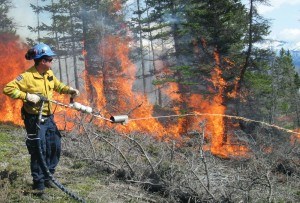 Parks Canada Fire Management update
Parks Canada Fire Management update
Jasper is a fire adapted landscape. The plants and animals living here are adapted to fire because, for thousands of years, wildfires naturally and frequently burned through our valley bottoms. Some local species even depend on fire for things like renewal and habitat.
An early park policy, however, meant that fire was virtually eliminated from the park for almost 70 years. Because of its absence, our present landscape now provides less grazing wildlife habitat, forests are dense and over-mature (ripe for forest insects and disease), and the risk of wildfire to our community has increased.
While protection of people and property will always be first priority, Jasper National Park’s Fire Management team also plans prescribed fires to help restore this important natural process. These fires are part of an on-going program to restore healthy forests, grasslands, and wildlife habitat, and to help reduce the risk of wildfire.
Here’s a snapshot of Fire Management’s prescribed fire work for this year:
Fireguard burning along Snaring Meadows, 20 km north of town, is complete for the year. This burning will help prepare for culturally significant meadow restoration in a future year.
The team’s present focus is to carry out necessary fireguard burning on the Vine Creek prescribed fire area, just over 20 km north of town. If weather and forest conditions permit, the team will carry out the prescribed fire later this spring or early summer.
This fall, small-scale prescribed fires are once again planned along the community fireguard behind the townsite.
Later in the fall, as conditions permit, small-scale prescribed fires will help restore sub-alpine meadows.
Would you like to receive email updates on park wildfires and prescribed fires? Please contact Kim Weir at 780-852-1891 or [email protected] to be added to the distribution list.
Bald eagles return to nest again!
They’re back. This year, bald eagles have two nests at the north end of Medicine Lake and, once again, a pair is nesting near the shore of Lake Annette. Eagles can be very sensitive to the presence of people near these nests and may abandon them if disturbed—please respect the space that these eagles need. To decrease the chances of people’s activity disturbing the nesting eagles, Parks Canada has issued small, temporary area closures directly around the nests. From just outside the closed areas, there are great opportunities to bring your binoculars and quietly observe the nests! These areas will re-open when the young eaglets can fly—approximately late July.
Bald eagles are fish-eaters during the summer months and nest near fish-bearing water bodies. They usually lay one to three eggs, and incubation is about 35 days. Once the eggs hatch, the male does most of the foraging while the female tends the young. Once the young can thermo-regulate on their own (three to four weeks), the female starts to forage as well. A young eaglet has a fledging period (the chick’s parents raising it to a fully grown state) of 10 to 12 weeks.
Parks Canada
Special to the 51����
